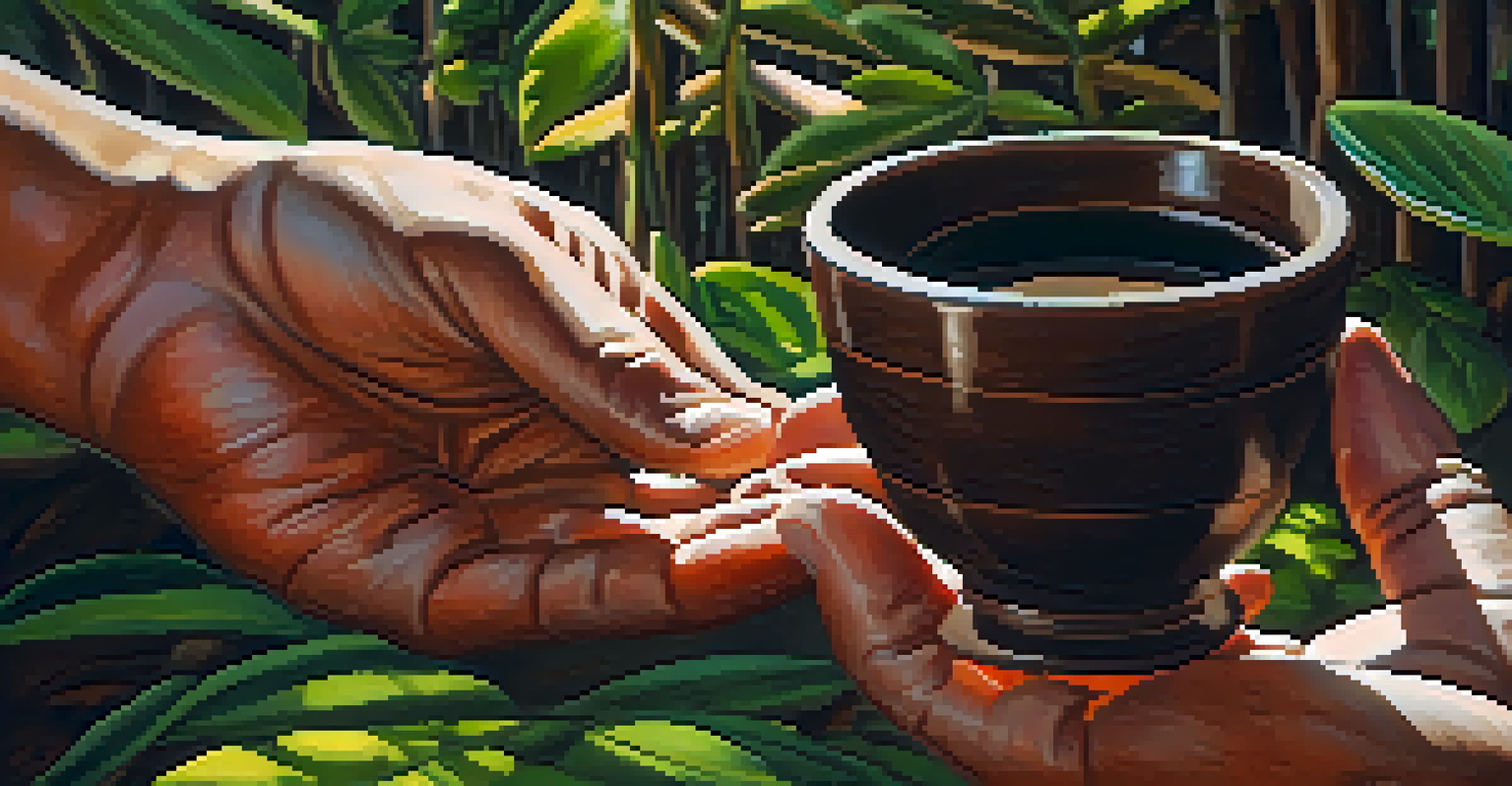How Ayahuasca Influences Emotional and Physical Sensations

Understanding Ayahuasca and Its Cultural Background
Ayahuasca is a powerful brew made from Amazonian plants, traditionally used in spiritual ceremonies by indigenous cultures. This sacred drink is known for its psychoactive properties, primarily due to the compound DMT. In these ceremonies, participants often seek healing, guidance, and a deeper connection to themselves and the universe, highlighting its cultural significance.
The mind is everything. What you think you become.
The use of Ayahuasca dates back thousands of years, and it plays a crucial role in the spiritual practices of many South American tribes. These rituals foster communal bonds and a sense of belonging while addressing individual emotional struggles. By understanding the cultural context, we can appreciate how Ayahuasca serves not just as a substance, but as a catalyst for personal transformation.
In recent years, Ayahuasca has gained popularity outside its traditional settings, attracting those interested in alternative healing methods. While this has sparked conversations about its benefits, it’s essential to approach it with respect and mindfulness, acknowledging the rich heritage and wisdom that accompany its use.
The Emotional Landscape of Ayahuasca Experiences
Many people report profound emotional experiences during Ayahuasca ceremonies, often described as a rollercoaster of feelings. Participants might confront buried traumas, release pent-up emotions, or experience overwhelming joy. This emotional journey can lead to catharsis, allowing individuals to process feelings that may have been suppressed for years.

The intensity of these emotions can be surprising, acting as a mirror that reflects personal struggles and triumphs. For example, someone may find themselves revisiting a painful memory, but rather than feeling stuck, they gain insight and understanding. This process can be both challenging and liberating, as it encourages individuals to embrace their vulnerabilities.
Cultural Significance of Ayahuasca
Ayahuasca is a sacred brew used in spiritual ceremonies by indigenous cultures, serving as a catalyst for personal transformation and communal bonding.
Moreover, the communal aspect of Ayahuasca ceremonies fosters a sense of safety, enabling participants to share their experiences without judgment. This shared vulnerability often leads to deep connections with others, enhancing the emotional healing process. Ultimately, the emotional landscape of Ayahuasca is as diverse as the individuals who partake in it.
Physical Sensations During Ayahuasca Ceremonies
While emotional experiences are prominent, physical sensations also play a significant role in Ayahuasca journeys. Many participants report a range of physical reactions, from nausea to intense body vibrations. These sensations can be uncomfortable but are often viewed as an essential part of the healing process.
The wound is the place where the Light enters you.
For some, the physical effects serve as a release mechanism, allowing the body to expel negative energies or toxins. This purging can be both literal and metaphorical, as participants often feel lighter and more liberated afterward. Understanding these sensations helps individuals prepare for the experience and embrace the physical aspects of their journey.
Additionally, some users describe heightened awareness of their bodies during the ceremony, feeling connected to physical sensations in a new way. This awareness can lead to insights about one’s health and well-being, encouraging participants to make positive lifestyle changes post-ceremony. Ultimately, the physical sensations experienced during Ayahuasca can be transformative, reinforcing the mind-body connection.
The Role of Set and Setting in Ayahuasca Experiences
The concepts of 'set' (mindset) and 'setting' (environment) are crucial when it comes to Ayahuasca experiences. A positive mindset can significantly influence how one processes emotions and physical sensations during the ceremony. Participants who approach the experience with openness and curiosity are more likely to have beneficial outcomes.
Setting also plays a vital role; a safe, nurturing environment enhances the potential for deep emotional and physical exploration. Traditional ceremonies often take place in natural settings, which help participants feel grounded and connected to the earth. This connection can amplify the healing aspects of the experience and promote a sense of tranquility.
Emotional and Physical Experiences
Participants often experience a rollercoaster of emotions and physical sensations during Ayahuasca ceremonies, which can lead to profound healing and self-discovery.
Moreover, the presence of a skilled facilitator or shaman can guide participants through their journey, providing support and reassurance. This guidance helps individuals navigate emotional challenges and physical discomforts, fostering a sense of safety. By prioritizing both set and setting, participants can create a more enriching and transformative Ayahuasca experience.
Integration: Making Sense of the Ayahuasca Journey
After an Ayahuasca ceremony, the integration phase becomes essential for translating insights into everyday life. Many participants find it challenging to process their experiences, making integration support crucial. This phase often involves reflection, journaling, and discussions with trusted friends or therapists.
Integration helps individuals make sense of their emotional and physical sensations, allowing them to apply newfound wisdom to their daily lives. For example, someone who confronted a past trauma may seek therapy to continue their healing journey. This step is vital for turning profound experiences into actionable changes.
Moreover, sharing experiences in community settings can foster a sense of belonging and support. Integration circles or group discussions provide a platform for participants to articulate their insights and feelings. This communal aspect reinforces the idea that healing is a shared journey, helping individuals feel less isolated in their experiences.
Potential Risks and Considerations of Ayahuasca Use
While many report positive experiences with Ayahuasca, it’s essential to acknowledge potential risks associated with its use. Individuals with a history of mental health issues, particularly psychosis, may experience adverse effects. It’s crucial to consult with a healthcare professional before participating in any Ayahuasca ceremony.
Additionally, the physical effects of Ayahuasca can be intense and uncomfortable. Nausea and vomiting are common, often referred to as 'purging.' While many view this as part of the healing process, it can be daunting for newcomers, emphasizing the importance of being mentally and physically prepared.
Importance of Set and Setting
The mindset and environment significantly influence Ayahuasca experiences, enhancing emotional exploration and the overall healing process.
Furthermore, finding a reputable facilitator or center is vital to ensure safety and support throughout the experience. Researching and choosing a place that prioritizes participant well-being can mitigate risks and enhance the overall journey. By understanding these considerations, individuals can navigate their Ayahuasca experiences with greater awareness and safety.
The Transformative Power of Ayahuasca on Personal Growth
Many individuals who engage in Ayahuasca ceremonies report significant shifts in their perspectives and emotional states. This transformation often manifests as increased self-awareness and a deeper understanding of one’s life path. For instance, someone might emerge from the experience with a clearer vision of their goals and aspirations.
Moreover, the emotional healing experienced during Ayahuasca ceremonies can lead to improved relationships. By addressing personal traumas and patterns, individuals often find themselves more compassionate and empathetic toward others. This ripple effect can enhance connections with family, friends, and the wider community.

Ultimately, the transformative power of Ayahuasca lies in its ability to foster personal growth and healing. As participants navigate their emotional and physical sensations, they often discover a renewed sense of purpose and belonging. This journey of self-discovery can inspire profound changes, making Ayahuasca a powerful tool for those seeking deeper meaning in their lives.